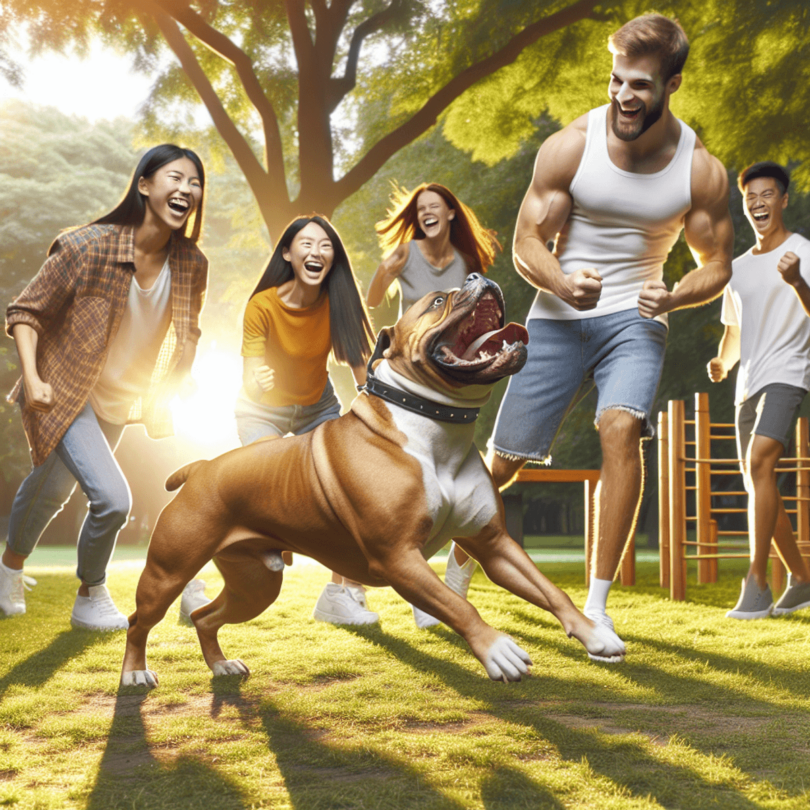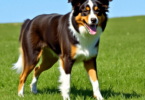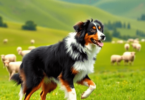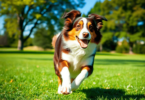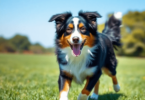Training Your American Bulldog: A Comprehensive Guide
Training your American Bulldog is not just a good idea—it’s essential! These muscular, strong, and high-energy dogs are known for their loyalty and trainability, but without proper guidance, they can become a handful. To help you navigate this exciting journey, we’ve compiled 10 essential American Bulldog training tips that every new dog owner should know.
Here’s what you’ll discover:
- Understanding the Breed: Learn the unique characteristics of American Bulldogs that impact training.
- Socialization: Early socialization tips to ensure your pup grows into a well-adjusted adult.
- Potty Training: Best practices for establishing a consistent potty routine.
- Exercise Needs: How to meet their daily exercise requirements effectively.
- Positive Reinforcement: Utilizing praise and treats for long-term benefits.
- Short Training Sessions: Keeping sessions engaging and brief to maintain attention.
- Respect-Based Training: A unique approach focusing on mutual respect rather than obedience.
- Behavior Management: Strategies for addressing common behavioral issues promptly.
- Consistent Schedule: The importance of a structured training schedule.
- Professional Help: When and how to seek expert guidance tailored to American Bulldogs.
Early socialization and positive reinforcement are key components in raising a well-behaved American Bulldog. By exposing your pup to various people, environments, and other animals early on, you’ll foster confidence and reduce anxiety. Rewarding desired behaviors with treats or praise not only makes training enjoyable but also strengthens your bond with your furry friend. Ready to dive in? Let’s get started!
1. Understanding the American Bulldog Breed
American Bulldogs are a fascinating breed with a rich history and unique traits that make them stand out. Known for their muscular build, boundless energy, and undeniable loyalty, these dogs require specific training approaches to harness their full potential.
Overview of the American Bulldog Breed
- History: Originating from the working dogs brought by immigrants to America, American Bulldogs were used on farms for tasks like catching livestock and protecting properties.
- Physical Traits: They typically have a strong, muscular build with a broad chest and powerful legs. Males generally weigh between 75-100 lbs, while females range from 60-80 lbs.
- Temperament: Loyal, protective, and often described as “gentle giants,” they are excellent family pets when properly trained and socialized. To gain a deeper understanding of their behavior, you can explore this comprehensive guide on the American Bulldog temperament.
Characteristics That Affect Training
Training an American Bulldog requires understanding their unique characteristics:
- Strength: Their physical strength can be both an asset and a challenge. Training should include exercises that help them channel their power constructively.
- Loyalty: Their deep bond with owners can make training more effective as they naturally want to please.
- Energy Levels: High energy means they need regular physical activity. Incorporate activities like long walks or agility courses into their routine to keep them engaged.
Importance of Understanding Dog Behavior for Effective Training
Understanding your dog’s behavior is crucial for effective training. Recognize the signs of stress or excitement in your American Bulldog:
- Body Language: Ears back, tail tucked, or excessive panting can be indicators of discomfort or anxiety.
- Vocalization: Whining or barking could signal a need for attention or discomfort.
These insights help tailor your training approach to fit your dog’s needs.
Learning Styles
American Bulldogs, like humans, have different learning styles. Identifying what works best for your dog can enhance the training process:
- Visual Learners: Respond well to hand signals and visual cues. Use gestures along with verbal commands.
- Auditory Learners: Better at picking up verbal commands and sounds. Maintain consistent tone and language during training sessions.
- Kinesthetic Learners: Thrive through hands-on activities and physical interaction. Interactive toys and games work wonders here.
Understanding these aspects helps in crafting an effective training regimen tailored specifically for your American Bulldog’s needs.
2. The Importance of Early Socialization for American Bulldogs
Dog socialization is a cornerstone of raising a well-rounded American Bulldog. Early socialization for puppies ensures they grow into confident, friendly, and balanced adults.
Benefits of Early Socialization for American Bulldogs
- Boosts Confidence: Puppies exposed to various stimuli become more adaptable and less fearful in unfamiliar situations.
- Improves Behavior: Well-socialized dogs are generally better behaved and less likely to develop aggression or anxiety issues.
- Enhances Relationships: A socialized dog is typically more comfortable around people and other animals, making interactions smoother and more enjoyable.
Tips for Socializing an American Bulldog with People and Other Animals
- Start Early: Begin socializing your Bulldog puppy as soon as they’re vaccinated.
- Introduce Gradually: Slowly expose them to different people, including men, women, children, and strangers.
- Positive Experiences: Pair new experiences with treats and praise to create positive associations.
Recommended Environments for Socialization
- Puppy Classes: These controlled settings allow puppies to interact safely with others of their age group.
- Public Parks: Ideal for meeting a variety of people and dogs in a natural setting.
- Busy Streets: Help your puppy get accustomed to the sounds and sights of urban environments.
Creating a comprehensive socialization plan tailored to your American Bulldog’s personality can set the stage for successful training sessions that follow.
3. Establishing a Potty Training Routine with Your American Bulldog
Potty training an American Bulldog can be quite the adventure, but with the right approach, it can be a smooth and rewarding experience. Here are some tips to get you started:
Best Practices for Potty Training an American Bulldog
- Start Early: The sooner you start potty training your American Bulldog puppy, the better. Young pups are more adaptable and quicker to pick up on new habits.
- Designated Spot: Choose a specific spot outside where you want your bulldog to do their business. Consistently taking them to this spot reinforces the behavior.
- Regular Intervals: Take your pup out at regular intervals—first thing in the morning, after meals, and before bedtime.
Importance of Consistency in Routine
Consistency is key when it comes to potty training. A reliable schedule helps your American Bulldog understand what’s expected of them.
- Set Timers: Use timers or alarms to remind yourself when it’s time for a potty break.
- Consistent Commands: Use the same command every time you take them out. Phrases like “Go potty” or “Do your business” work well.
- Routine Reinforcement: Stick to your routine even on weekends or holidays to avoid confusing your furry friend.
Using Rewards to Encourage Desired Behaviors
Positive reinforcement can make all the difference during potty training.
- Treats Galore: Have treats ready to reward your bulldog immediately after they’ve done their business in the right spot.
- Praise and Affection: Don’t underestimate the power of a good belly rub or enthusiastic praise!
- Patience is Key: Sometimes accidents happen. Stay patient and avoid scolding; instead, reinforce positive behaviors consistently.
By following these steps, you’ll be well on your way to successfully potty training your American Bulldog!
4. Meeting the Exercise and Mental Stimulation Needs of Your American Bulldog
To keep your American Bulldog in great shape, both physically and mentally, a well-rounded exercise routine is essential. These strong dogs love to be active and require a combination of physical activities and mind-challenging games.
Daily Exercise Requirements
Here’s what you should aim for:
- 30-45 minute walks: A brisk walk around the neighborhood or a local park will do wonders.
- High-energy activities: Think fetch, tug-of-war, or agility courses. These dogs love to play!
Regular exercise not only keeps them healthy but also prevents any built-up energy that might lead to undesirable behaviors. However, it’s important to note that too much exercise can be harmful for large breed dogs, so always monitor their activity levels.
High-Energy Activities
Engage your bulldog with:
- Fetch: A classic! Just be sure to use a durable ball or toy.
- Tug-of-War: This is excellent for their strength and can be a fun bonding experience.
- Agility Training: Set up a mini obstacle course in your backyard.
These activities burn off energy and keep their bodies strong.
Mental Stimulation
Don’t forget about their minds! Here are some fun ideas:
- Interactive toys: Consider mentally stimulating dog toys that are tough like puzzle feeders or treat-dispensing toys which can keep them occupied.
- Scent games: Hide treats around the house and let them sniff them out.
- Training sessions: Short, engaging training sessions can also provide mental exercise. If your dog has a tendency to only want to sniff during walks, exercising them in such a manner might prove challenging but it’s worth the effort.
Keeping both their bodies and minds active leads to a happier, healthier American Bulldog.
5. Using Positive Reinforcement Techniques Effectively with Your American Bulldog
Understanding positive reinforcement in dog training is key to fostering a happy and well-behaved American Bulldog. This method focuses on rewarding desired behaviors to encourage their repetition.
Why Positive Reinforcement Works
Positive reinforcement methods involve:
- Treats: Small, tasty rewards that your bulldog loves.
- Praise: Verbal affirmations like “Good boy!” or “Well done!”
- Toys: Playtime with a favorite toy as a reward.
By associating good behavior with these rewards, your bulldog learns that behaving well leads to positive outcomes. This approach is not just effective but also backed by research which highlights its benefits.
How to Use Treats and Praise Effectively
- Immediate Rewarding: Ensure you give the treat or praise immediately after the desired behavior. This helps your bulldog link the action to the reward clearly.
- Consistency: Be consistent in your rewarding. If your bulldog gets a treat for sitting today, they should get one every time they sit on command.
- Varying Rewards: Mix up the rewards—sometimes use treats, other times use toys or praise. This keeps training exciting and unpredictable.
The Role of Treats vs Praise in Dog Training
When it comes to using treats and praise effectively, it’s essential to understand their respective roles in the training process. Treats are often seen as a primary motivator due to their immediate and tangible nature, while praise reinforces emotional bonds and encourages good behavior.
Benefits of Punitive Measures
Positive reinforcement offers several long-term benefits:
- Strengthened Bond: It fosters a trusting relationship between you and your bulldog.
- Increased Motivation: Your dog will be more eager to learn and engage in training sessions.
- Reduced Fear and Anxiety: Unlike punitive measures, positive reinforcement doesn’t induce fear or stress in your dog, leading to a happier pet overall.
Using positive reinforcement techniques effectively can transform your training sessions into enjoyable experiences for both you and your American Bulldog!
6. Keeping Training Sessions Short and Engaging for Your American Bulldog
When it comes to American Bulldog training tips, one golden rule is to keep training sessions short and sweet. Bulldogs, like many dogs, have a limited attention span. Aim for training sessions that last between 5 to 10 minutes. This ensures your furry friend stays focused and engaged without feeling overwhelmed or bored.
Strategies to Keep Sessions Engaging
- Mix It Up: Variety is the spice of life, and this holds true for dog training too! Alternate between different activities such as American Bulldog leash training, obedience commands, and fun tricks.
- Interactive Toys: Incorporate toys that can make learning fun. For example, use a favorite chew toy as a reward for mastering new American Bulldog training commands.
- Praise & Treats: Use plenty of verbal praise and tasty treats to keep your pup motivated. A happy “Good job!” followed by a treat can work wonders.
Importance of Variety
Maintaining your bulldog’s interest requires a diverse array of activities. Switch between:
- Basic commands (sit, stay, come)
- Advanced tricks (roll over, play dead)
- Practical skills (leash walking, potty training)
This not only keeps the sessions enjoyable but also helps in reinforcing different areas of learning simultaneously.
An example: Start with a 5-minute session on basic commands before moving on to a short game of fetch. This variety keeps them alert and eager to learn more.
By implementing these engaging strategies, you’ll find that your American Bulldog remains enthusiastic, making each session productive and enjoyable!
7. Respect-Based Training Methodology: A Unique Approach to Training Your American Bulldog
Respect-based methodology in dog training offers a fresh take on how you can build a meaningful relationship with your American Bulldog. Unlike traditional obedience methods that often rely on commands and compliance, this approach centers around fostering mutual respect and understanding between you and your furry friend.
How Respect Impacts the Owner-Dog Relationship
Respect transforms the dynamic between you and your American Bulldog. When your dog respects you, they are more likely to listen and cooperate willingly rather than out of fear or obligation. This method strengthens the bond, making training sessions more productive and enjoyable for both parties.
Real-life Applications of Respect-Based Techniques
- Body Language Awareness: Understanding your dog’s body language can help you respond appropriately to their needs and emotions. For example, if your bulldog shows signs of stress during a walk, pausing to reassure them can help build trust.
- Consistent Leadership: Being a consistent leader means setting boundaries while also showing kindness. Encourage good behavior through rewards but maintain firm rules about what is acceptable.
- Interactive Play: Engage in activities that both you and your bulldog enjoy, such as tug-of-war or fetch. These games not only provide physical exercise but also reinforce positive interactions based on mutual enjoyment.
Understanding dog behavior is key in applying respect-based methodology effectively. You’re not just teaching commands; you’re nurturing a relationship where your American Bulldog feels safe, understood, and valued.
8. Managing Common Behavior Problems Effectively in Your American Bulldog
Addressing common behavioral issues in bulldogs can make life smoother for both you and your furry friend. Some typical challenges include chewing, separation anxiety, and excessive barking.
Identifying Common Behavioral Issues
Here are some common behavioral issues you may encounter with your American Bulldog:
- Chewing: Bulldogs are notorious for their strong jaws and love to chew on anything within reach.
- Separation Anxiety: Many Bulldogs become anxious when left alone, leading to destructive behavior. This is a common dog behavior issue that can be particularly challenging.
- Excessive Barking: While not as common as chewing or anxiety, some Bulldogs may bark excessively if not properly trained.
Strategies to Address Undesirable Behaviors
It’s crucial to tackle these problems without resorting to punishment. Here are some effective behavior management strategies:
Chewing Solutions
- Provide appropriate chew toys that are durable and safe.
- Rotate toys to keep your Bulldog interested.
Managing Separation Anxiety
- Gradually practice alone-time by leaving your dog alone for short periods and slowly increasing the duration. For more detailed strategies on managing dog anxiety, refer to this helpful guide on treating dog anxiety.
- Use interactive toys or treat-dispensing puzzles to keep them engaged when you’re away.
Reducing Excessive Barking
- Identify triggers for barking and work on desensitizing your dog to them.
- Use commands like “quiet” with positive reinforcement whenever they stop barking.
Seeking Professional Guidance
If these strategies don’t resolve the issues, seeking professional help is a wise move. Consulting a veterinary behaviorist can provide specialized insights tailored to your Bulldog’s unique needs. They can help devise a comprehensive plan that addresses the root cause of the behaviors effectively.
With these tips, you’ll be well-equipped to handle any behavioral hiccups and ensure a happy, well-adjusted American Bulldog!
9. Implementing a Consistent Training Schedule for Success with Your American Bulldog
Creating a structured daily/weekly schedule is crucial for effective American Bulldog training. This includes:
- Formal obedience practice sessions: Dedicate specific times of the day to work on commands and behaviors. For example, mornings can be reserved for sit, stay, and recall exercises.
- Informal opportunities: Reinforce good manners throughout the day. Use everyday moments like mealtime or playtime to practice commands and reward positive behavior.
Balancing different types of training keeps things engaging:
- Obedience training: Focuses on basic commands and manners. Short sessions (5-10 minutes) help maintain interest.
- Agility training: Incorporate activities like obstacle courses or agility drills. This not only provides physical exercise but also mental stimulation.
Keeping training fun is key:
“Training should be an enjoyable experience for both you and your dog!“
Rotate between different activities to keep your bulldog engaged and excited about learning.
American Bulldog Training Tips
- Consistency is key: Stick to your schedule to build reliable habits.
- Use positive reinforcement: Reward desired behaviors with treats, toys, or praise.
- Mix it up: Alternate between obedience and agility exercises to prevent boredom.
By combining structured schedules with varied activities, you’ll ensure your American Bulldog remains a well-trained and happy companion!
10. Seeking Professional Help When Needed: Finding the Right Trainer or Class for Your American Bulldog
Sometimes, even the most dedicated dog owners need a little extra help. Here’s when to consider hiring a professional trainer:
- Managing Stubbornness: American Bulldogs can be headstrong. If leash walking turns into a tug-of-war, professional trainers experienced with bulldogs can provide specialized techniques to make walks enjoyable.
- Behavioral Issues: Common problems like separation anxiety or excessive chewing might need a more tailored approach. Canine behavioral consultants can offer strategies that are specific to your dog’s needs.
Benefits of Expert Guidance
Expert guidance goes beyond basic commands:
- Personalized Training Plans: Professionals understand how to motivate individual dogs based on their personality traits rather than using cookie-cutter methods. This personalized approach ensures more effective training.
- Experience and Knowledge: Trainers who specialize in bulldogs bring a wealth of experience. They know the intricacies of the breed and can offer unique American Bulldog training tips that you might not find in general dog training resources.
Investing in professional help can turn challenging behaviors into opportunities for growth, making life with your American Bulldog both fun and rewarding!
FAQs (Frequently Asked Questions)
What are the key characteristics of the American Bulldog that affect training?
American Bulldogs are known for their strength, loyalty, and high energy levels. Understanding these breed characteristics is crucial for effective training, as they influence how an American Bulldog responds to various training methods.
Why is early socialization important for American Bulldogs?
Early socialization helps American Bulldogs develop into well-adjusted adults. It exposes them to different people, environments, and other animals, reducing the likelihood of behavioral issues later on. Positive experiences during this critical period can foster confidence and good behavior.
What are the best practices for potty training an American Bulldog?
To successfully potty train an American Bulldog, establish a consistent routine and take them out regularly. Use rewards like treats and praise to encourage desired behaviors. Consistency is key to reinforcing good habits.
How much exercise does an adult American Bulldog need?
An adult American Bulldog requires daily exercise of about 30-45 minutes. Engaging in high-energy activities such as fetch or tug-of-war can help meet their physical needs while also providing mental stimulation.
What is positive reinforcement and how can it be used effectively with my American Bulldog?
Positive reinforcement involves rewarding desirable behaviors with treats or praise to encourage them. Using this method during training sessions helps build a positive relationship with your bulldog, leading to long-term benefits compared to punitive measures.
When should I consider hiring a professional trainer for my American Bulldog?
You should consider hiring a professional trainer if you encounter challenges that seem overwhelming or if your dog displays stubborn behaviors that are difficult to manage on your own. A trainer experienced with bulldogs can provide tailored guidance that addresses your dog’s unique needs.
